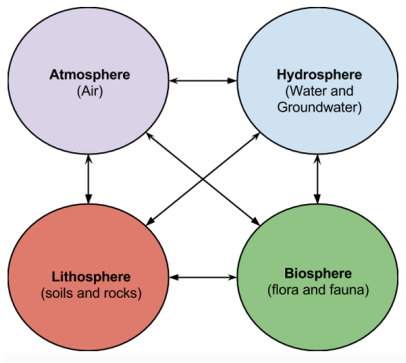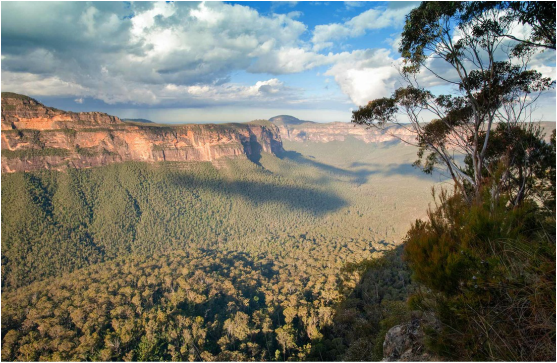Biophysical Interactions
All ecosystems are a direct result of the biophysical elements of a given locality. The atmosphere, hydrosphere, lithosphere and biosphere all interact with each other at any given place.
The interactions of ecosystem are unique to any given place, but generalisations can be made. For example, the patterns of rainfall that occur at particular latitudes produce familiar biomes, such as arid lands or tropical rain forests at predictable places.
The Blue Mountains ecosystem is a clear example of unique interactions. The sandstone lithosphere been uplifted and interacted with the hydrosphere to weather the bed rock to produce stunning canyons and cliff faces. Moreover, the atmosphere creates a climate which accommodates a diverse range of flora and fauna in a ecological system.
The interactions of ecosystem are unique to any given place, but generalisations can be made. For example, the patterns of rainfall that occur at particular latitudes produce familiar biomes, such as arid lands or tropical rain forests at predictable places.
The Blue Mountains ecosystem is a clear example of unique interactions. The sandstone lithosphere been uplifted and interacted with the hydrosphere to weather the bed rock to produce stunning canyons and cliff faces. Moreover, the atmosphere creates a climate which accommodates a diverse range of flora and fauna in a ecological system.
Later in the course, students will be able to apply their understanding of the biophysical environment with the human geography they have learned to see how human activity impacts on the physical world.
Syllabus
the biophysical environment
• the nature and functioning of the four components: the atmosphere, hydrosphere, lithosphere and biosphere in a specific biophysical environment including:
– atmospheric processes, climatic components, climatic variation
– operation of the water cycle and the role of water in geomorphological processes
– parent material, slope processes, weathering, mass movements, erosion, transport and deposition, and the fluvial, aeolian and/or coastal geomorphological processes
– the variety and distribution of plants and animals and soil formation
• the interactions between, and the human impacts on, the functioning of the atmosphere, hydrosphere, lithosphere and biosphere.
biophysical processes and issues
• a case study investigating ONE issue in ONE of the biophysical components, to illustrate how an understanding of biophysical processes contributes to sustainable management in the environment. The investigation will include:
– identification and explanation of the key biophysical processes which relate to the issue
– scale of operation
– interactions with other components of the biophysical environment
– the sensitivity of the biophysical environment to change
– the importance of understanding key biophysical processes for effective management
• the issue should be selected from ONE of the following components:
– in the atmosphere, one issue such as greenhouse warming, acid rain, ozone depletion
• the nature and functioning of the four components: the atmosphere, hydrosphere, lithosphere and biosphere in a specific biophysical environment including:
– atmospheric processes, climatic components, climatic variation
– operation of the water cycle and the role of water in geomorphological processes
– parent material, slope processes, weathering, mass movements, erosion, transport and deposition, and the fluvial, aeolian and/or coastal geomorphological processes
– the variety and distribution of plants and animals and soil formation
• the interactions between, and the human impacts on, the functioning of the atmosphere, hydrosphere, lithosphere and biosphere.
biophysical processes and issues
• a case study investigating ONE issue in ONE of the biophysical components, to illustrate how an understanding of biophysical processes contributes to sustainable management in the environment. The investigation will include:
– identification and explanation of the key biophysical processes which relate to the issue
– scale of operation
– interactions with other components of the biophysical environment
– the sensitivity of the biophysical environment to change
– the importance of understanding key biophysical processes for effective management
• the issue should be selected from ONE of the following components:
– in the atmosphere, one issue such as greenhouse warming, acid rain, ozone depletion
Practice extended response questions
- Analyse the factors that determine global patterns of climate and local patterns of weather.
- Explain how an understanding of biophysical processes contributes to the sustainable management of the sclerophyll environment.
- Examine the impact that the hydrosphere and human activity have on each other around the world.

